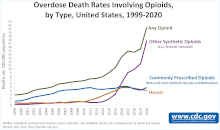Opioid epidemic in the United States
In the United States, many prescribed painkillers use opioids. Opioids are effective at suppressing pain, but they can cause addiction. When people take opioids for a longer period of time, they will get addicted. Because of this, many people in the U.S. are addicted, and there are also many addiction-related deaths. This is known as the opioid crisis or opioid epidemic [2]

The crisis intensified during the COVID-19 pandemic. According to the CDC, almost 841,000 people died from drug overdoses between 1999 and March 2021.[3] Most of them had become addicted to painkillers that were previously prescribed.[4] The increase in deaths from drug overdoses is thought to be partially caused by an increase in isolation (doing drugs alone) during COVID, meaning that people could die more easily by not having others to watch over them.
One such opioid is fentanyl. Since 2018, fentanyl and its analogues have been responsible for most drug overdose deaths in the United States, causing over 71,238 deaths in 2021.[5][6] Fentanyl caused more deaths than other opioids or opiates.
In 2023, it is said that "more Americans than ever are dying from fentanyl overdoses".[7] The number of people dying because of fentanyl has increased with the illicit manufacture of the drug, and by its use with methamphetamines. 111,000 people died from January to April 2023 - more than those who died in car accidents.
Narcan is a drug that can be used to reverse or reduce the effects of opioids. It is available in vending machines in some Chicago subway stations. It can be bought without a prescription in some states, and in some places it is free.[8]
Movie
changeThe Crime of the Century is an American two-part documentary movie, directed, produced, and written by Alex Gibney. The movie follows the opioid epidemic in the United States, and the political operatives, government regulations and corporations that enable the abuse of opioids, particularly the Sackler family and Purdue Pharma. It was aired in two parts beginning on May 10, 2021, and May 11, 2021, by HBO.
Books
change- Eric Eyre, Death in Mud Lick: A Coal Country Fight Against the Drug Companies That Delivered the Opioid Epidemic. Scribner, New York 2020, ISBN 978-1-9821-0531-0
- Travis D. Stimeling (ed. ): The Opioid Epidemic and US Culture: Expression, Art, and Politics in an Age of Addiction. West Virginia University Press, Morganstown 2020, ISBN 978-1-949199-70-3 .
- Wendy Welch (ed. ): From the Front Lines of the Appalachian Opioid Crisis: Healthcare Providers on Addiction and Healing. McFarland & Co, Jefferson 2020, ISBN 978-1-4766-8226-6 .
- Dopesick: Dealers, Doctors, and the Drug Company that Addicted America. Little, Brown and Company. 2018. ISBN 978-0-316-55124-3.
- Barry Meier: Pain Killer: An Empire of Deceit and the Origin of America's Opioid Epidemic. (First published 2003; expanded and updated edition. Random House, 2018, ISBN 978-0-525-51110-6 ).
- Chris McGreal, American Overdose: The Opioid Tragedy in Three Acts . Public Affairs, 2018, ISBN 978-1-61039-861-9
- David E. Newton: The Opioid Crisis: A Reference Handbook. Greenwood Press, Westport 2018, ISBN 978-1-4408-6435-3 .
- Patrick Radden Keefe, The Family That Built an Empire of Pain. The Sackler dynasty's ruthless marketing of painkillers has generated billions of dollars—and millions of addicts. In: The New Yorker, 30. October 2017.
Other websites
change- Berit Uhlmann: Opioid crisis in the USA. A country under drugs, In: Süddeutsche Zeitung from 26. October 2017
- Josh Katz: Drug Deaths in America Are Rising Faster Than Ever . In: The New York Times of 5. June 2017
- Opioid Epidemic: Addicted Newborns in the US Archived 2022-01-28 at the Wayback Machine . Art, 2018
- The Endless Crisis - The Lost Battle Against Opioids in the USA . Podcast by Deutschlandfunk from 3. October 2021
References
change- ↑ Data Overview. Drug Overdose. CDC Injury Center, Centers for Disease Control and Prevention 2016.
- ↑ Marc Pitzke: Pharma-Dynastie Sackler - Der Drogen-Clan, Der Spiegel, 18. Februar 2019, abgerufen am 24. November 2021.
- ↑ "Data Overview | CDC's Response to the Opioid Overdose Epidemic | CDC". 2021-10-15. Retrieved 2021-11-24.
- ↑ Opioid-Krise in den USA: Eine Nation auf Drogen (S+). 2021-11-14. ISSN 2195-1349.
- ↑ "Fentanyl overtakes heroin as the No. 1 opioid overdose killer". www.cbsnews.com. Retrieved 2023-02-20.
- ↑ "Drug Overdose Death Rates". National Institute on Drug Abuse. 2023-02-09. Retrieved 2023-02-20.
- ↑ BBC News: How the fentanyl crisis' fourth wave has hit every corner of the US. [1]
- ↑ Waldmeir, Patti (2023-09-18). "Tactics are shifting in the war on drugs". Financial Times. Retrieved 2023-09-19.